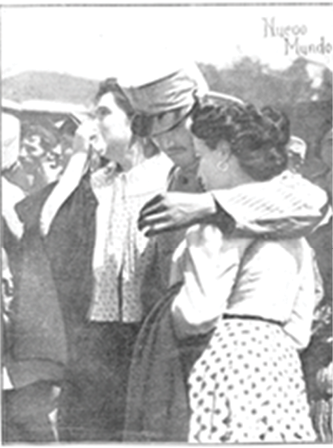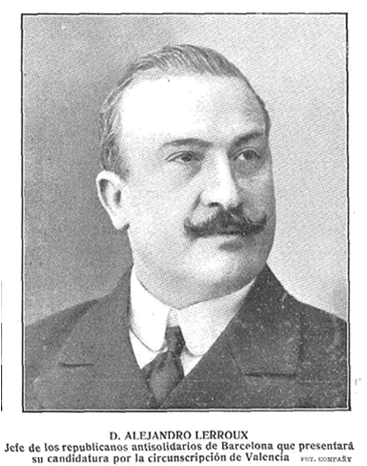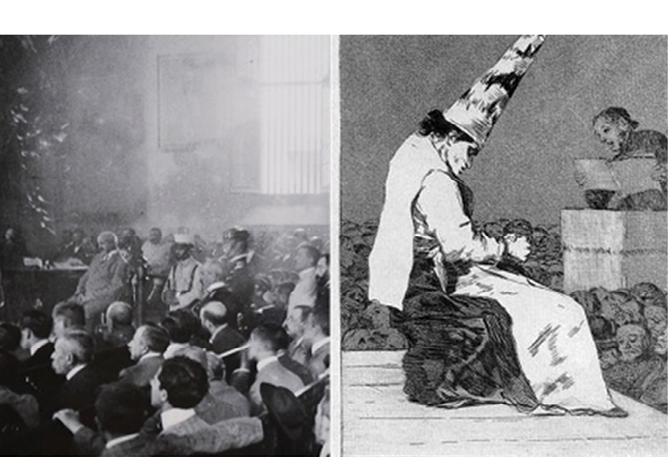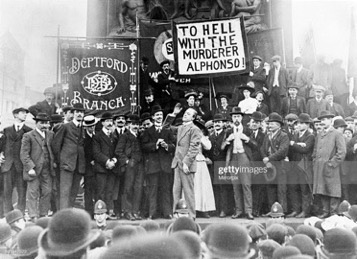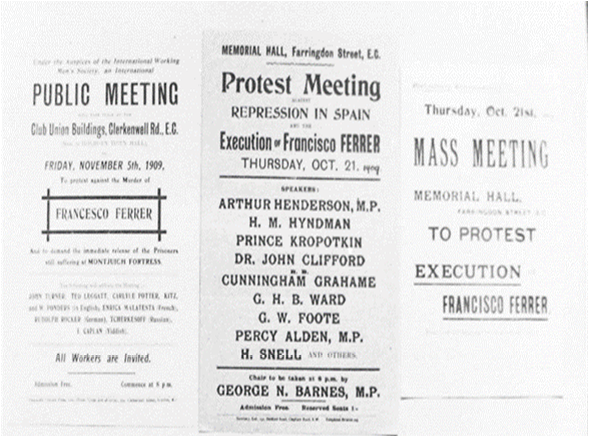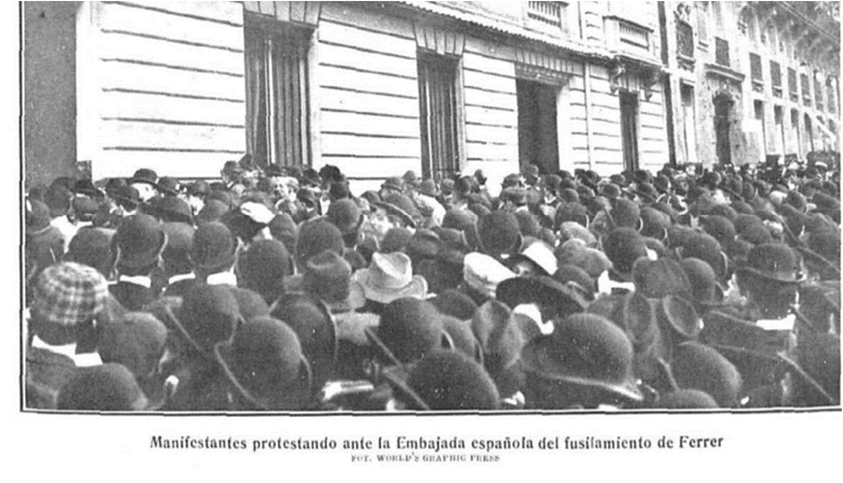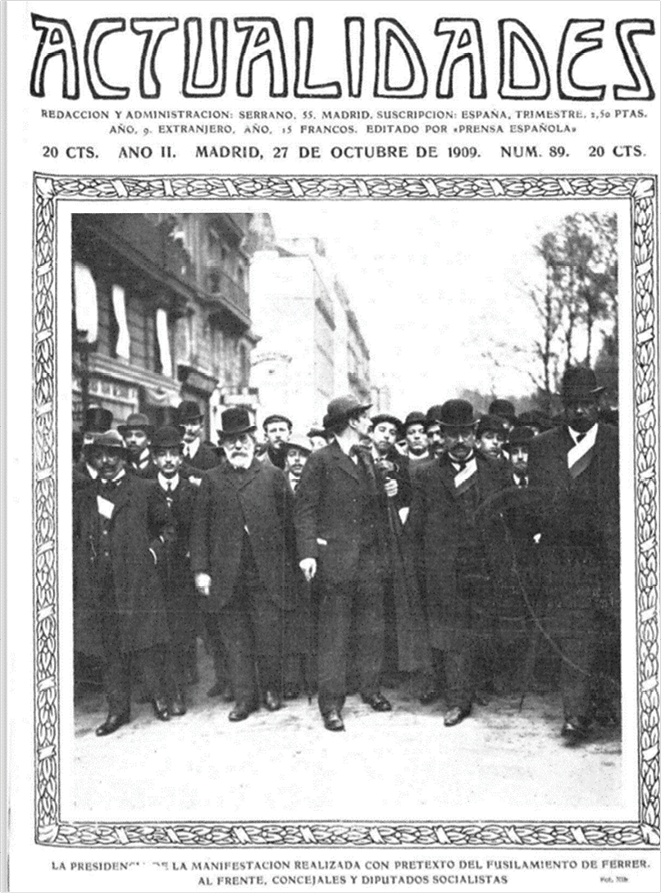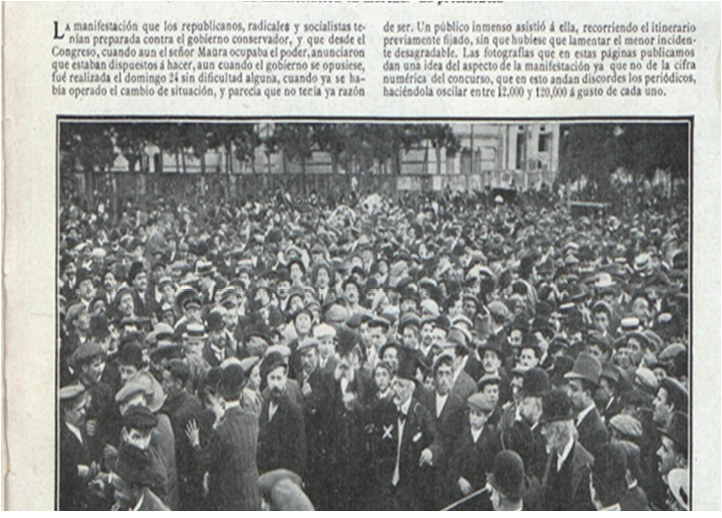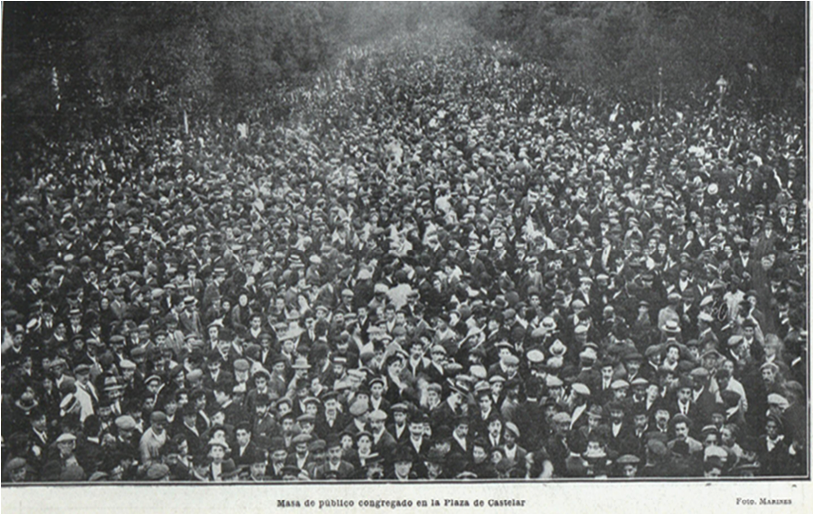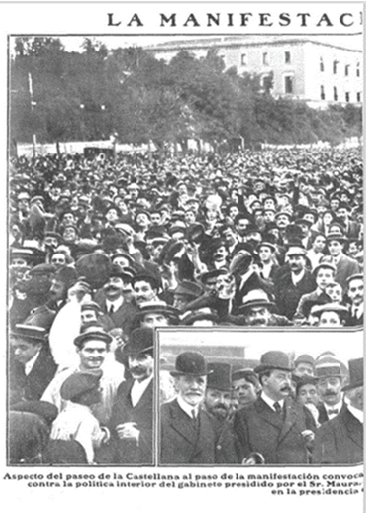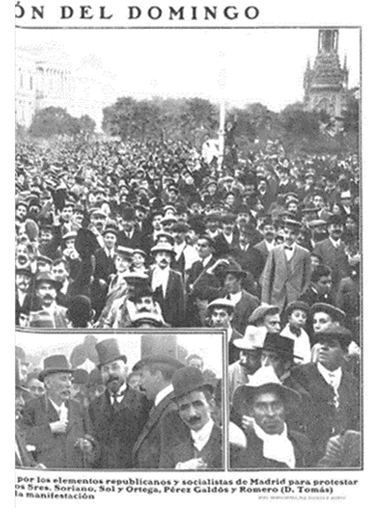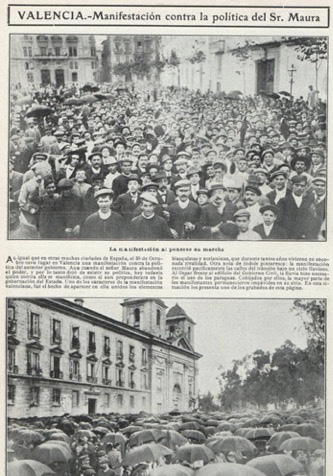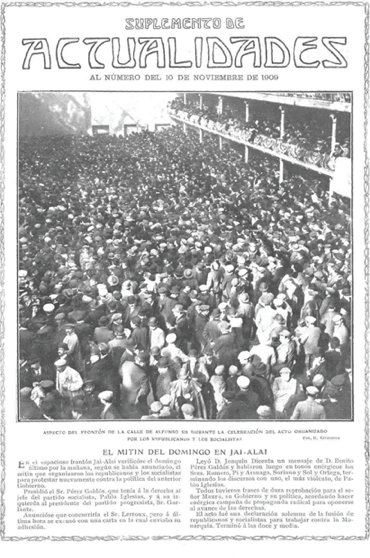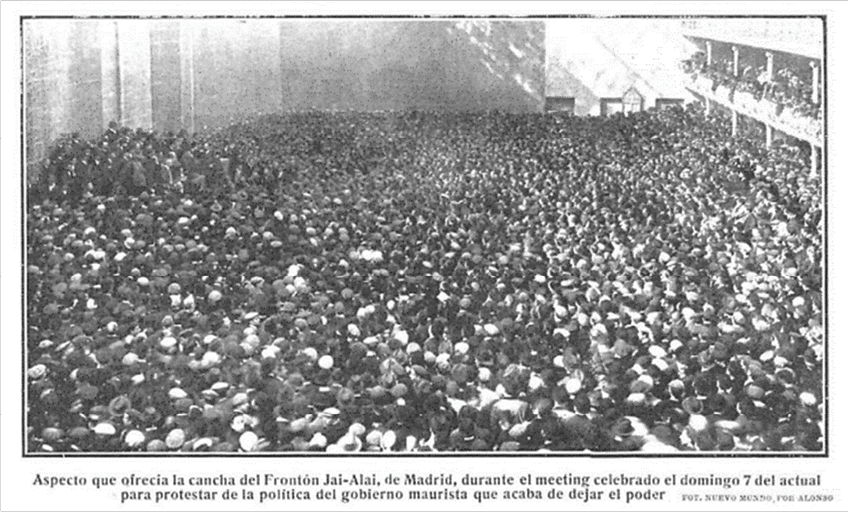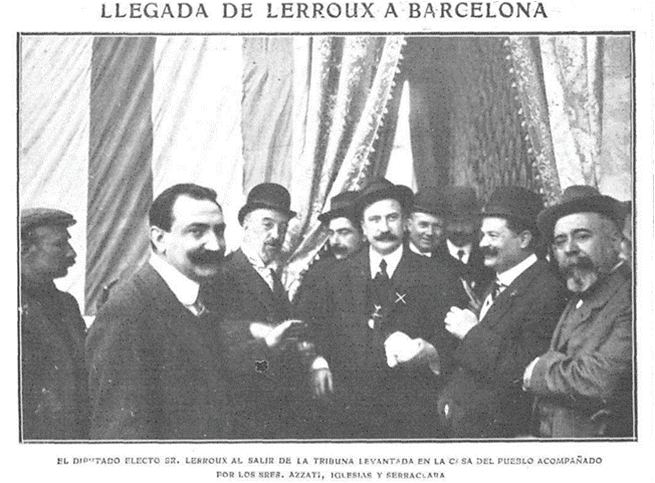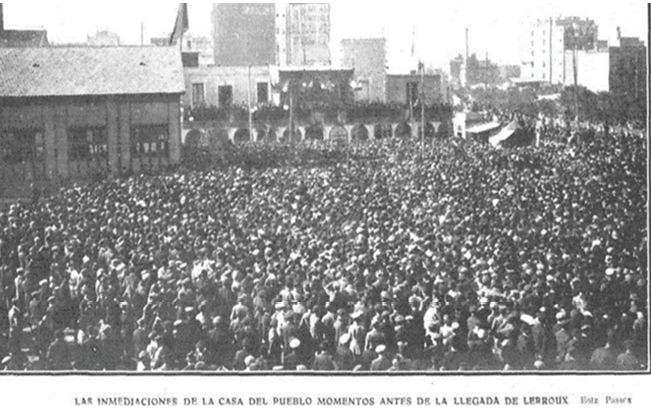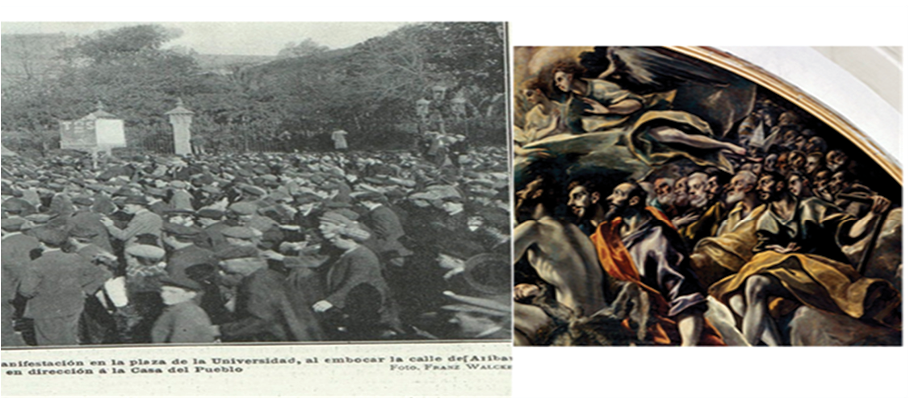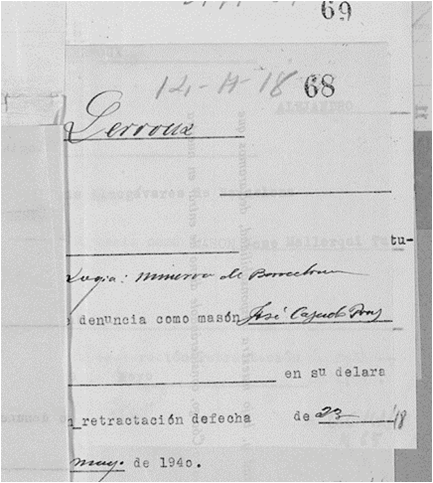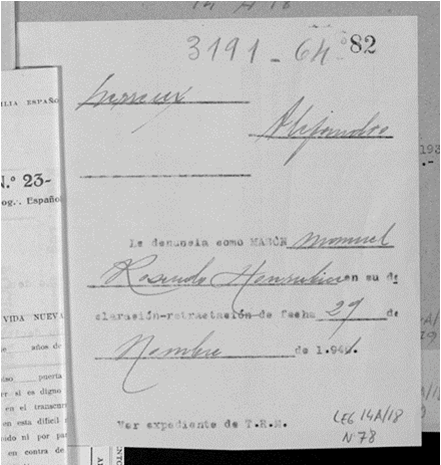The Tragic Week in Barcelona 1909 and a Tale of Two Freemasons
La semana trágica en Barcelona en 1909 y un cuento sobre dos masones
Sylvia Hottinger Craig
Universidad Carlos III de M adrid, España
sylvia.hottinger@gmail.com
ORCID: 0000-0001-6391-2726
The author would like to thank Professor Andrew Prescott, Dr David Wearing and the sadly recently deceased D, Juan Avilés Farré (1950-2023) for their support and help in writing this paper.
Receipt: 15th January 2024/Acceptance: 25th February 2024
doi: https://doi.org/10.15517/rehmlac.v16i2.56876
Keywords
Photography; Freemasons; Barcelona; Tragic Week; Spain
Palabras clave
Fotografía; masones; Barcelona; Semana Trágica; España
Abstract
Through a revision of the sources and use of photographs of the 1909 Tragic Week in Barcelona, we see how the Spanish Empire not only persecuted those it colonized people but also its own citizens. This is not only the first visual representation of the Empire Against Its Own, but also the story of the two Freemasons accused of having orchestrated a rebellion. The first photographed upheaval in the history of Spain, its depiction of a barricade revolution is often confused with those of the Spanish Civil War (1936-1939) in Barcelona.
Resumen
A través de una revisión de las fuentes de la Semana Trágica en Barcelona y el estudio de las fotografías de los eventos de 1909 vemos como el Imperio español no solamente persiguió a las personas que colonizó sino también a la gente de su propio pueblo. Igualmente, es la historia de los dos masones acusados de organizar la rebelión. Algunas de estas imágenes se confunden con las fotografías hechas durante la Guerra Civil Española en Barcelona (1936-1939).
Introduction
The Tragic Week of Barcelona in 1909 is noteworthy not only for its intrinsic historical importance but also because it was the first Spanish revolt for which a visual representation in the form of photographs survives. Many photographs of the Tragic Week are often wrongly identified as images of the Spanish civil war in Barcelona. The Tragic Week has various names like the 1909 Revolution or the Disasters in Barcelona. In the early 20th century, Spain had a limited democracy, and a general strike in Catalonia escalated into a rebellion, mainly targeting churches. This event caught the establishment by surprise because lower-ranking soldiers joined the revolt, and external military intervention led to serious casualties and arrests. Two prominent freemasons, Alejandro Lerroux and Francisco Ferrer Guardia were accused of precipitating the rising. Photographs unexpectedly captured the events, reinforcing perceptions of workers’ struggle and creating a visual identity for them. The paper will examine overlooked sources for the study of this rising and consider how these contribute to a better understanding of the tragic week.
Despite a press bias against workers and the accused Freemasons, photographs offer a different perspective. The paper analyzes these images on three communication levels: semantics, photographic communication, and iconographic similarities. It illustrates the distinction between what is shown and omitted in photographs.
The analysis of photographs includes various aspects. The evidential value of some can be directly confirmed through observations, documents, and their messages. Others benefit from comparisons with familiar images, known as the “iconography of a photograph.” Certain images reflect the interplay between speech acts and their wider social, political, and cultural context, as described by Bredekamp1. However, it is important to recognize that photographs show only part of the story, with some elements left unseen or omitted, as emphasized by Amador Carretero2.
In the early 1900s, photography had technical limitations, often requiring subjects to pose. Some images align with official accounts, while others contradict them. This paper also examines the photographers and their portrayal of the three key social groups: the army, the Catholic Church, and the workers.
The Army
Spain lost its last colony in 1898 and the loss of its colonies, especially Cuba, is still a reference point for defeat. Phrases like “More was lost with Cuba” are used in this context. There’s also the saying “the last one from the Philippines” for someone consistently late or slow to catch on. The loss of the colonies also affected Freemasonry, as it lost credibility in Spain due to accusations of supporting independence movements in Latin America. However, some Masonic lodges started operating again in Madrid and Barcelona by 1900.
Alvarez Junco explains that the Spanish authorities, particularly King Alphonse xiii, were unprepared for the losses suffered by the Spanish army3. Public opinion in Spain was not enthusiastic about colonial endeavours, and the Spanish people had a different attitude towards colonial wars compared to the English or the French. Spain’s remaining colonies were limited to steel mines in Morocco’s Rif region, privately owned by four conglomerates: the Figueroa group, the Marques of Comillas and Guell’s group, the McPherson group, and the Fernandez group. These mines in the Rif region faced attacks by Moroccans violating agreements with the Spanish government.
In July 1909, Moroccan rebels attacked and killed railroad workers, leading to government mobilization. In response, trade unions, anarchist groups, and the socialist party organized an anti-war General Strike in major cities like Madrid, Barcelona, and Valencia4. This strike had a social and political focus, not just economic one5.
Image 1
The photograph, taken by Alonso (1884-1937), a member of the Union of Graphic Informers of Madrid who also used the pseudonym Felix Ortiz Perrello, was featured on the cover of one of the rare, illustrated weeklies. It captures a poignant moment as a soldier bids farewell to two female relatives. The soldier appears sombre, as do the women on his right. The woman on his left, who has her arm around him, is crying. The two women wear clothing made of the same fabric, suggesting a close connection, possibly as sisters. Their physical closeness implies a strong family bond. The trio is surrounded by a crowd, seemingly unnoticed by others except the photographer. Their lack of eye contact with the camera suggests absorption in their own emotional moment. A second soldier is visible behind the main figure. The two women are modestly dressed and attractive. The soldier may be holding a cigarette.
This cover of Nuevo Mundo6 reflects the Spanish people’s distress over the second mobilization and was published a week after the Tragic Week events. The crucial moment was on July 18, 1909, as the 3rd Cazadores Brigade bade farewell to their loved ones at 5 pm during the public evening stroll. Protests against the new draft were erupting nationwide. It was the second time these reserves were drafted again, and only those who could afford a 6000 reales exemption were spared. Given that a worker’s annual wage was just ١٠ reales, this was a significant financial burden for many families. Some of these men had been allowed to marry and start families before being drafted again, making their return as draftees particularly challenging. Witness Bonafulla described how women and relatives sparked a rebellion by shouting, “Either we all go, or no one goes.”7
Image 2
Joan C. Ullman noted that the ceremonies before embarkation appeared designed to incense the masses. This is supported by Castellá’s image in El Nuevo Mundo. Enric Castellá Marqués shared his images of Barcelona in contemporary illustrated magazines8.
The first press photograph shows troops crowded onto a ship while the Marquise of Comillas, the ship’s owner’s wife, distributes holy medals and tobacco pouches to drafted men. However, her husband, the second count of Comillas (1883-1925), had a controversial background, being the son of a slave trader and ship merchant. He was known for his close ties to the Catholic Church and his business dealings with them, including renting his ships to the Spanish army for transporting men to Morocco. Several illustrated magazines at the time, like Actualidad, Las Actualidades, and Nuevo Rumbo, published photos of the crowds and the Countess of Comillas distributing items.), who photographed Barcelona’s social life until 19179.
His works were published in the already mentioned Spanish illustrated press as well as in the Catalan speaking magazines such as Ilustració Catalana and Feminal.
In July, as further military embarkations occurred, General Ossorio banned war protesters. Luis de Santiago, appointed by Governor Ossorio, managed the situation, as Ossorio refused to declare war on the people of Barcelona. Dissatisfaction with the monarchy grew. Ossorio once wrote that revolutions are always ready, not planned. Initially, the army seemed to side with the workers, as seen in photographs.
Image 3
On the weekend of July 24-25, an illegal meeting was held by Fabra Ribas, the socialist party leader, and Tomas Herreros, head of the anarchist movement. News of the meeting spread through Casas del Pueblo instead of the Solidaridad Obrera Union. The general strike escalated with workers picketing public transport, trams, and setting up barricades. The army entered Catalonia in response to the workers’ rebellion, not to Catalan nationalism.
Magin Vidal y Ribas, writing under a pen name in l’Humanité, argued that there was no logical Catalan separatist element among the strikers. The workers did not align with Catalan nationalists, who were mainly factory owners, intellectuals, and clergy10. Separatism was discussed only among literary figures and idealists; the bourgeoisie did not support the revolution, as they did not want to challenge established powers. Workers sought to expand their fight, and separatism was not a topic in proletarian meetings or newspapers11.
The invading army in Barcelona comprised soldiers from various Spanish regions like Alcantara and Vergara. The emerging Catalan movement withdrew its support, and the Catalan bourgeoisie sought protection from Madrid12. The conservative authorities were astonished to see workers and women taking charge of the streets. Even an article in El Aveu Catalan encouraged readers to report those involved in burning religious buildings. Church structures were targeted, and the clergy were urged to leave, with force used if they refused. Solidaritat Catalana, once a rival to Lerroux’s politics, had dissolved, but the Catalan republican left remembered how Le Veu de Catalunya newspaper had described the rebellion as embarrassing13.
Photographs of this event made available online are frequently mixed with unrelated barricade images, while in exhibitions they are displayed alongside unrelated work, which can be misleading. The Church’s exploitation of workers, including profiting from their labour in food production, was considered unethical and unfair competition to other industries14. Attacks on religious buildings were seen as acts of anticlericalism, symbolizing the perceived unruliness and irrationality of the protesting workers.
Image 4
In this photograph of the barricades (Image 4), we see soldiers passively standing around while the figures stare defiantly at the photographer. The main figures are staring at the camera. The ones in shirt sleeves have their arms crossed defiantly. There is a figure sitting or kneeling behind a low barricade probably in the process of being built and is surrounded by children. In the centre there is a dark figure which could be a woman. The soldiers to her right are also staring at the camera as if stopped in their steps. The figure to the left with folded arms shows the height of the barricade. There is another man also in his shirt sleeves who seems to be stacking cobblestones. are also starring at the camera as if stopped in their steps. The figure to the left with folded arms shows the height of the barricade.
This is a scene that has been stopped to pose for the photographer. The soldiers do not seem to participate in the building of the barricades, but neither are they putting a stop to it. Their stance conveys informal chat rather than an official position. They want to be included in the photograph of the barricades. The children in the forefront seem to be playing, they are wearing rather impoverished attire, they too are also looking at the photographer. In the forefront there are two little girls: one is looking towards a crouching figure which may be that of a woman and the little girl is looking at her mother. To the right there is only a stray dog who is uninterested in the scene but conveys a sense of movement.
Image 5
In this photograph, we see what Marin describes15. It depicts the building of a barricade. There is a sense of urgency since most figures are working on the same task and they are too busy to pose for photographs. The focus of the photograph is on the female figure dressed in black and the lads picking up cobblestones. On the right side of the image, we see the shadows of the roof top of a building, indicating that the photographer is shooting the photograph from inside a doorway. There is a single figure on the left with a cap covering his face as he looks at the photographer. To the left of the busy group there are four men looking on at the task in progress. One of the four male onlookers, one is distant from the others, he seems to be more middle class as he is wearing a jacket. The other three men in that group, are they overseeing the building of the barricade? They turned their back to the camera.
The barricades were built on Tuesday 27 when the workers’ strike became a general revolutionary strike. It was also when the Guardia Civil and the troops were shot at from balconies and private dwellings. The barricades were built by men, women and children. Over 300 square meters of cobblestones from the streets were used to build them16.
The Catholic Church and the Workers
In Spain, historians now view the Catholic Church as a victim of workers’ irrationality and fanaticism, with the anti-clerical movement seen as a reaction to the Church’s dominant position. The Church had strong support from the army, nobility, and wealthy bourgeoisie, often involving wealthy family members entering the clergy.
In the early 20th century, the Church controlled education, including its structure and content, banning some science subjects, and determining which books were forbidden due to perceived immorality. They also adapted Catholic guilds to counter trade unions, providing work opportunities for those following Catholic practices and offering activities like chess and reading. These centres even had church-owned stores, allowing the church to influence employment and support workers through charity, putting them in competition with workers’ movements.
In 1872, Catholic Church circles, inspired by the French model of Count Mou, served as bankers for the poor17. In 1872, Spain introduced its version of savings banks known as “Caja de Ahorros y Montes de Piedad”. In Barcelona, these banks were called “canters,” and by 1904, there were approximately 157 of them. By 1910, Spain had a thousand Mutual Help centres in operation.
The iconic image of the Tragic Week is a photograph by José Campúa, a Spanish photojournalism pioneer and a pupil of the freemason Manuel Compagny, showing the burning of religious buildings in Barcelona. The photo was shot from Montjuich Mountain in Barcelona. However, it is believed that these were retouched for dramatic effect, with the churches being set on fire in Barcelona being meant to recall the burning of Rome.
Image 6
Another factor contributing to the Church’s negative image was the myth created by the novelist Galdos in his play “Electra” (1843-1920), where the heroine is forcibly sent into a convent. Rumors spread about nuns being buried with their fetuses and facing violence from the Church hierarchy, as documented by Martinez Hoyos in 202018. Furthermore, protests arose due to the significant number of deceased individuals being buried in convent gardens near residential areas, raising concerns about public health, especially during a period when diseases like cholera were affecting Barcelona’s population.
On Wednesday the city woke up in flames (…) There were over thirty thousand revolutionaries in the city: women, man, youth and old took over the streets under the passive eyes of the bourgeoisie and the army, who were a minority, did not dare to open fire but the Madrid government sent garrisons of soldiers from other regions of Spain telling them that the source of the trouble was a rebellion.
Women drag 15 corpses of nuns to the City Hall then to the House of Comillas and of
Eusebio Guell.
The following two days, Tuesday and Wednesday, approximately 50 Church buildings, including convents, schools and churches, were burnt down. Two friars were killed and there was some sacking, but goods were mostly shown to the public and would end up in a pyre. Tombs were also broken open to find proof of nuns being tortured since their feet and hands were tied or the secret tombstones of unborn children, consequences of orgies with priests19.
Alvarez Junco proposes that the Barcelona fires had their origins in medieval anticlericalism, and ultimately aided the emergence of Catalan nationalism20. Ullman suggests the fires spread the revolutionary spirit, while Culla argues they were a spontaneous people’s outburst21. Marin argues that displaying dead bodies during the July revolution in Barcelona played a key role in creating a new proletarian identity by challenging traditional sacred beliefs22. Nuns, not officially registered as employers, had women working for them, and they themselves worked without pay in exchange for room and board, unlike working-class women who had no such support23 Mitjana attributes the shift from revolution to anticlericalism to a spontaneous rebellion driven by various grievances among the popular classes against the Church, including unfair labour conditions and benefits only for Church supporters24.
In 1905, Barcelona had 155,822 workers, with 44,129 being women, accounting for 28% of the workforce. This was double their representation in the total population, which stood at 15%. It is worth noting that this census did not include domestic workers, women performing tasks like ironing, sewing, and rag picking at home, or young girls and individuals in prostitution25.
Two prominent women’s groups were “Las Damas Rojas” and “Las Damas Radicales.” The former had established by-laws and steering committees, while the latter, consisting of middle-class women interested in secular education and followers of Lerroux, began collaborating in 1906. Mitjana and Martínez say that the fact that the Damas Radicales were informed about the strike shows that some radical republicans knew about the preparations to strike although not all of them were in favour of it. They mention some renowned names like Sol y Ortega or Emiliano Iglesias, accusing them of wanting their cake and eating it26.
Although many women were illiterate, they remained informed as those who could read often read aloud for others. Micaela Chalmeta, writing under the pen name Amparo Martí, penned a front-page article in La Internacional on July 25, 1909, criticizing the working conditions in Barcelona’s convents. She accused the nuns of exploiting women through low wages, excessive working hours, and unfair competition, as they could produce goods more cheaply than factories. Chalmeta argued that the issue was not religion but rather exploitative working conditions and unfair competition by the nuns against the workers.
A year after the Tragic Week, the Damas Rojas, a Barcelona women’s society, were believed to have connections to Freemasonry, especially because their leader, Maria Angeles Lopez de Ayala, was a Freemason herself. Previously, her group, Sociedad Progresiva Femenina, had been active since ١٨٩٨ and shared premises with a male lodge, Logia Constancia, of which she was a member. They also had an alliance with the Damas Radicales and their leader Lerroux in 1910.
In Madrid, the Damas Rojas were founded by Consuelo Álvarez Pool, a journalist, feminist, and Republican Freemason, in 1908. She used the pen name Violeta in the press and went by the masonic name Costa27. Another potential indicator of their masonic origins was the mention of a tutor or master named Luis Bertrán, described as an anarchist and teacher at the Modern School. Such a role as a tutor may be relevant, as adoption lodges often included women, with a male Master from a connected men’s lodge. However, there is no documented masonic record for Bertrán, who is only listed as a radical follower of Lerroux and counsellor to the Damas Radicales during the Tragic Week28.
Images 7 and 8
Álvarez Junco is the only one to connect the Tragic Week in Barcelona and the Paris Commune, citing similarities in isolated cities and military reversals. However, examining visual similarities, particularly comparing images of executed communards with pictures of desecrated nuns during the Tragic Week, suggests that displaying the nun›s remains in Barcelona was a form of revenge in response to the disturbing photographs of executed workers in Paris. This juxtaposition highlights the similarity in how cadavers were exhibited in both cases.
…apparently “evident” visual comparisons, relationships between images are more implicitly asserted than verbally or contextually, deduced. (...) It is a rhetorical quality of comparative presentation that showing two images in juxtaposition tends to suggest relationships more than distinctions, just a position of two or more images on a surface or in space seems to suggest a certain direction in which to read them. The legitimacy of a presented comparison can only be determined by the verbal argumentation that accompanies it. That also means that the respective interests in it must be disclosed and made transparent29.
Photographs by Castelló also show holy statues propped up similarly, indicating this practice might not be exclusive to displaying nuns’ remains. It could be due to technological limitations in photography at the time, making it easier for photographers or participants to capture deceased individuals in such positions. However, these images do not resemble traditional family mortuary photographs, though occasionally, the deceased’s coffin may also be propped up30.
Executed members of the Paris commune were photographed naked with numbers on their chests. The purpose behind doing this remains a mystery. However, the way in which the coffins were arranged and presented to the photographer shows a clear intention to shame these individuals. This might have been an attempt to mirror the way the bourgeoisie had shamed their own heroes during the reprisals of La Commune.
Although most participants in the Tragic Week were either not born or children during the Commune of Paris, the worker networks between Spain and France had constant communication. It is likely that the photographs of the Commune were known to most workers. For instance, there was a commemoration issue dedicated to the Commune in the socialist newspaper La Internacional in the same year, on March 19, 190931.
Republicans, Freethinkers and Freemasons
Barcelona, a historic port city, has a rich history of embracing diverse influences, including exotic goods and drugs from around the world. The migration of workers from various Spanish regions, especially Andalusia, to Catalonia for employment in factories and workshops marked the early growth of trade unions and political parties. Spain’s connection with France extended beyond geographical proximity, as opponents of the monarchy often found refuge or exile there. This French influence on the Spanish middle class led to the establishment of freemasons’ lodges and meetings, serving as centres for political education and organizational training. These lodges played a vital role in Spain’s political development and the emergence of associated educational institutions.
Before the approval of the 1887 Law of Association in Spain, legal restrictions were in place32. In 1839, a law allowed Societies of Mutual Help but not Societies of Resistance, while the 1848 Penal Code punished illegal associations which sought to pressure employers for better working conditions and wages. The 1887 law finally granted freedom of association to various groups, including religious, political, scientific, managerial, and workers’ organizations.
Freemasonry in Spain encountered legal challenges, prompting many lodges to register as recreational, educational, or cultural groups to operate without restrictions33. Around the turn of the century, numerous freethinkers were also part of freemasonry, which played a crucial role in providing inclusive education across social classes and genders. Many freethinkers developed their political knowledge and ideals within these lodges.
Freemasons and anarchists in late 19th-century Barcelona promoted education for working classes and women, organizing worker centres and printing presses that influenced the Spanish workers’ movement. They established 110 non-religious schools in Catalonia from 1882-1896. However, they faced accusations of supporting Cuban and Filipino rebels in 1889, leading to blame for the loss of colonies. They reorganized in 1900 as Gran Logia Simbólica Regional Catalana Balear but still faced clerical persecution. Freemasons and anarchists in Barcelona were associated with worker internationals, and the Library Arús played a vital role in preserving masonic materials during Franco’s purges. The Centre for Lay Education and its newspaper, La Luz, promoted free thinking, anarchism, and education, welcoming members known for honesty and good habits from Barcelona and nearby areas.
This historical context underscores the interconnectedness of freemasonry, anarchism, education, and freethinking during this period34. Although Alejandro Lerroux and Francisco Ferrer Guardia were friends and collaborators for 17 years, there are no known photographs of them together35. This could be because Ferrer Guardia, a reserved teacher and publisher, contrasted with the outgoing Lerroux, a populist politician.
Lerroux and Ferrer Guardia first met in Madrid, living in different places, under the mentorship of the republican Manuel Ruiz Zorilla. Their friendship deepened in Madrid when Ferrer Guardia presented his revolutionary plans at a Universal Congress of Freethinkers in 1892. Initially considered romantic and unrealistic, Ferrer Guardia’s proposal found passionate support from Lerroux, then an editor for El País. Lerroux even expressed his willingness to be the first volunteer for Ferrer’s revolutionary initiative.
In 1885, Francisco Ferrer Guardia left his native Catalonia after being caught using his job at the railway company to facilitate communication between republicans inside and outside Spain. Like many during King Alfonso xiii’s reign, he was forced into exile.
Image 9. Alejandro Lerroux
Meanwhile, Alejandro Lerroux was sent to Barcelona with the task of expanding his growing support among the workers and encouraging them to participate in the first local elections allowed by the monarchy. Lerroux was a popular figure among the workers, writing newspaper articles and delivering speeches in support of those who had been imprisoned and tortured by the government. According to the interpretation of Catalan historian Marin, Lerroux played a significant role: “Lerroux arrived in Barcelona, sent by [Minister] Moret as an agent provocateur, to deactivate the Catalan republican project and manipulate the workers, most of them were migrants from Southern Spain. Thanks to a populist and demagogic political project, Lerroux gradually disenchanted his followers.”36
On the other hand, Alvarez Junco in this case defends Lerroux:
Alejandro Lerroux, in conclusion, didn’t have anything to do with missions funded by the central government to make Catalan nationalism fail. It would be fairer to describe him as one of the many adventurers that arrived in Barcelona at that time. Neither did he introduce class conflicts in Catalonia which weren’t already rooted before him. Nor was he the instigator of the workers and the republican’s hostility against Catalan nationalism, which was there prior to his arrival and were based on well -founded reasons. Catalan society did not react unanimously against him, nor was Catalan nationalism at that time a generalized political feeling.
These workers were very receptive to this Andalusian republican who spoke of revolution in their accent. The crowds attended his rallies with cries of approval and although his rhetoric was violent, according to the temper of the times, it was never meant to be taken literally. Alvarez Junco observes, “And, in spite the belief one could have in the belief of rationality in politics, he seduced Barcelona. This use of the verb ‘seduce’ is not an exaggeration”37. “His only weapon was his rhetoric: his newspaper articles and his speeches in rallies”.
In 1903, the first local government suffrage occurred, with 41 out of 44 elected deputies in Barcelona forming a republican coalition comprising Catalan nationalists, radical republican federalists, and Lerroux’s radical republicans. Lerroux’s popularity played a significant role in this electoral victory.
While in Paris, Francisco Ferrer Guardia was well-known as a successful Spanish language teacher and author of “L’Espagnol Pratique.” He traveled extensively in France, Belgium, and Switzerland, visiting newly established rational schools. In 1901, his educational activities started gaining prominence. Ernestina Meunié, a former student, coincidentally left Ferrer Guardia an inheritance in the same year, enabling him to implement his educational ideas. With a general pardon allowing Spanish exiles to return to Spain, Ferrer Guardia established the first rational school in Barcelona, known as the Modern School. He maintained friendly relations with the Catalana Balear Obedience, led by Alejandro Lerroux and his followers. However, Ferrer Guardia’s interactions with the Grand Master of the Grande Oriente Español, Morayta, in Madrid were less cordial. Ferrer Guardia disapproved of Morayta’s lack of revolutionary fervor, while Alonso-Según described Morayta’s attitude as non-political38.
Historians have only recently acknowledged the friendship and alliances between Alejandro Lerroux and Francisco Ferrer Guardia. Both were politically active, albeit for different reasons, in support of workers’ causes. Lerroux’s successful campaign for the Montjuic prisoners had a lasting impact on Catalan workers and solidified his fame. He served as a Member of Parliament for Barcelona for the entire 22-year duration of Canovas’s system. Anarchists and republicans shared a common enemy in the Catholic Church and the monarchy during the Restoration period.
Image 10
Lerroux also led a protest campaign against the 1906 arrest of Ferrer Guardia and Jose Nakens, accused of plotting to assassinate King Alfonso during his wedding in Madrid. The attempted assassination, carried out by Mateo Morral, a friend of Ferrer Guardia, resulted in 26 deaths. Morral was shot after hiding in Nakens’ office and was believed to have shot himself while fleeing. The extensive campaign for Ferrer Guardia’s defence pressured the army into releasing him a year later, while Nakens had to wait another year but was eventually acquitted. Ferrer and Lerroux received support from newspapers in Madrid, Barcelona, and other Spanish cities, as well as from papers in Belgium, Italy, and Portugal. In England, Ferrer Guardia had the support of freethinker William Heaford and Horatio Bottomley39.
Lerroux argued that Ferrer’s initial arrest was a pretext to target secular education and undermine republicans, freethinkers, and freemasons. He believed the establishment aimed to obstruct the advancement of secular education, a significant point of conflict. During his 1906 campaign, Lerroux recognized that he could gain support from like-minded individuals in various European countries by highlighting this issue.
Alejandro Lerroux had joined the Antorcha lodge in Madrid in the 1880s, and according to Franco’s Special Court Against Freemasonry in 1945, he was initiated into the “Verónica” lodge in Madrid in 1886, using the symbolic name Giordano Bruno and eventually achieving the rank of Master Mason of the ٣rd Degree. In 1917, he joined the “Adelante” lodge in Barcelona, remaining there until 1931. In 1932, Lerroux settled his outstanding dues and transferred to the “Union” lodge in Madrid.
Ferrer Guardia, also a Freemason, joined the Verdad lodge in Barcelona in 1883 under the symbolic name Zero. Within a year, he had reached the third degree. In 1890, he joined the Les Vrais Experts lodge of the Grand Orient de France and swiftly advanced through the degrees, reaching degree 31 in 1897. However, some argue that his commitment was more towards French Freemasonry than his Spanish counterparts.
In 1901, Ferrer Guardia became a member of Les Amis Bienfaisants. Although he was granted leave in 1906, he remained a lodge member while in prison. After his release in 1907, he returned to Paris but stopped attending meetings and paying dues, leading to his exclusion from the lodge in December 190840. It is essential to note that Ferrer Guardia was not a Freemason during the Tragic Week events. In 1907, he went back to Paris but he had stopped attending the meetings and paying his dues, so he was excluded from the lodge in December 1908. Ferrer was potentially a link between anarchy and freemasonry since some of his friends such as Anselmo Lorenzo (1842-1914), Odon del Buen (1863-1945) and Cristobal Litrán (1861-1926) were anarchists.
His Masonic reputation and the title “Martyr of Freethinkers” were posthumously bestowed upon him, particularly by international Freemasons from countries like Belgium, France, and Italy. However, during his lifetime, he had been excluded from both Belgian and French lodges, with no documented proof of him attaining the 31st degree. His Masonic reputation seems to have grown after his execution.
Ferrer transitioned from his earlier pursuits to embrace anarchism. Initially acquainted with influential Spanish anarchist Anselmo Lorenzo in Barcelona, he later befriended French anarchist Charles Malato after moving to Paris41. However, his full commitment to anarchism appears to have happened after the death of Ruiz Zorrilla and his unsuccessful involvement with socialism. Ferrer Guardia and Lerroux were republicans, not socialists. The Socialist Party, founded by Pablo Iglesias in 1874, had a different ideology. “Republican” broadly described opposition to the monarchy, including various parties aiming for a non-monarchial and democratic state. Republican parties included the Radical Republican Party, from which Lerroux split, the Federal Republican Party, and the Progressive Liberal party. Initially, republicans sought support and votes from the workers’ movement, mainly consisting of anarchists originating from trade unions and guilds.
In September 1908, Lerroux left for Buenos Aires from Marseilles, where Ferrer hoped he could secure financial backing for a revolutionary movement. Lerroux had recently founded the Partido Republicano Federal and had to flee Spain due to a prison sentence. In Buenos Aires, he embarked on a fundraising mission, aided by Dr. Calzada, a fellow Spanish republican residing there. Throughout their acquaintance, Ferrer consistently believed that Lerroux was the right person to lead the revolution42.
The leaders of the Grand Lodge Regional Catalana Balear, later becoming the Gran Logia Española in 1921, were drawn to Lerroux’s populism and anticlericalism, supporting or becoming members of his radical political party as a result.
Lerroux, returning from Argentina, altered his plans and headed to London upon learning of the revolt.
The Modern School on trial
In 1901, while both Ferrer Guardia and Lerroux resided in Barcelona, Ferrer Guardia founded the first Modern School, dedicated to providing education free from religious influence. This school welcomed children from diverse social backgrounds and both genders, emphasizing subjects like politics and natural sciences. Additionally, with assistance from Anselmo Lorenzo, Ferrer Guardia established a publishing company producing educational materials for the school and printing Marxist and anarcho-syndicalist essays.
The Modern School also offered evening courses for workers. Lerroux, inspired by similar initiatives in Belgium known as “Les Maisons du People,” supported Ferrer’s efforts by financing courses for workers in “las casas del pueblo.” These venues became crucial cultural and political centers for Barcelona’s workers.
During the Tragic Week, as tensions escalated towards a revolution, Ferrer returned to Barcelona in an attempt to mediate and find a resolution, but his efforts proved unsuccessful. Shortly after his return, he went back home and was arrested a few weeks later, somewhere between his house and a nearby village. Under martial law, he was detained and accused of leading the revolution, which led to a court-martial.
Ferrer had withdrawn 70,000 pesetas from his account, with the intention of donating it to Solidaridad Obrera, a coalition of republicans, anarchists, and socialists who organized and initiated the strike. Of this money, 900 pesetas were intended to cover the rent for the organization’s premises. It can be firmly concluded that Ferrer did not financially support the rebels of the Tragic Week. Nonetheless, he was falsely accused of leading the rebellion and ultimately sentenced to death. Ullman’s account incorrectly states that Francisco Ferrer was captured on August ٣١, 1909, while attempting to escape to France43. In reality, Ferrer was in his village near Barcelona. At this time, the governor ordered the closure of all 34 rational schools, including ١٨ in Catalonia44. In a letter to his partner, Soledad Villafranca, Ferrer explained that he was walking to the nearest train station with the intention of going to Barcelona to surrender himself to a judge.
Despite contrary claims, the case against Ferrer was primarily based on his revolutionary inclinations. His activities during the Tragic Week were just one instance among broader allegations that he had consistently aimed for a revolution in Spain throughout his career. To support their claims, military prosecutors used evidence from Ferrer’s career and writings, essentially following the same evidence and procedures that had resulted in his acquittal by civil judges in 190745.
Avilés presents evidence of documented abuses and lack of justice in Ferrer’s case. Despite our knowledge of the truth, there’s a dispute. Key points about Ferrer’s case:
1.He didn’t interfere with the movement.
2.He didn’t fund delegates’ travels.
3. He didn’t harm anyone. Evidence included books, documents, medals, letters, and measures to isolate him. His family and friends were exiled. Ferrer endured a month of solitary confinement. In September, he was questioned about his visits to Barcelona, faced a court-martial, and had limited defense time. Accusations of lending to Solidaridad Obrera could not be countered with Modern School books during the trial.
The main evidence against Ferrer included books, documents, a masonic apron and sash, medals, bans, and letters46. Authorities isolated him by exiling his family and friends like José Ferrer, Soledad Villafranca, Anselmo Lorenzo with his family, Mariano Ballori, and Cristobal Litrán47.
Ferrer endured a month of solitary confinement in a bleak cell. In September, he was questioned three times about his Barcelona visits, money distribution, and more. He faced a court-martial with Captain Francisco Galcerán Ferrer, leading his defense, given just 24 hours to review 600 pages of the indictment. The defense couldn’t use Modern School books to counter accusations of lending to Solidaridad Obrera by Lerroux’s party during the trial.
Regarding Lerroux, he was lucky to be out of Spain, for it spared him the cowardly campaign of accusations that his followers cast against Ferrer. With regards to that, Lerroux only sent a letter to their common friend and revolutionary [Charles] Malato [1857-1938), in mid-September, the following telegram: “I have never attributed any anarchist affiliation to Ferrer for I believed that he was a republican like me. Our association was political. Make this public.”48
During his time, Ferrer and Lerroux were thought to be involved in the 1906 regicide attempt by Morral. Ferrer was seen as promoting profanity by Catholics and a traitor by radical republicans due to his support for anarchists. On September 30, the republican newspaper La Publicidad called for a pardon for those sentenced to death, supported by poet Joan Maragall. However, his article on the matter was never published by La Veu de Catalunya. In one of his final letters to Soledad Villafranca around October 11-12, 1909, Ferrer Guardia expressed his distress, saying, “I can’t go on; my life is being taken from me...”49
Merletti (1860-1943) captured the iconic photo of Ferrer Guardia on the dock during his court-martial. This photograph, while not his ultimate masterpiece, greatly enhanced Merletti’s reputation as the era’s top photojournalist. He had discreetly smuggled a camera into the courtroom to capture this significant moment.
Images 11 and 12
The photograph of Ferrer Guardia shows him with his head tilted to the left due to his hearing impairment. Its composition bears a resemblance to Goya’s etching number ٢, believed to be a criticism of the Inquisition. Both figures of the accused have similar postures. The light from the window on the right-side illuminates Ferrer Guardia and the soldier guarding him, creating a contrast with the darkness in the rest of the courtroom, filled with onlookers and faint outlines of solicitors and magistrates.
Huxley notes that Goya (1746-1828) could not openly criticize the Inquisition under Ferdinand vii (1784-1833)50. Goya’s sketch, titled “Those Specks of Dust,” in the Prado Museum represents a woman accused of selling powder to lovers, highlighting how minor issues can lead to bigger problems. The connection to the Inquisition goes beyond the court-martial setting. Ferrer was falsely accused of funding a revolution and publishing rebellious books, posing a significant threat to the Catholic Church in that era.
The Modern School had three main activities: regular education, Sunday lectures for adults, and a publishing company. Prominent figures like Odon del Buen and the renowned anarchist Anselmo Lorenzo gave lectures. Ferrer emphasized science and hygiene in education, and they published works by authors like Karl Marx, Sorel, and Odon de Buen, who was both a teacher at the school and a Professor of Science at the University of Barcelona. The Modern School’s publishing company produced over 117 books between 1901 and 192051.
Ferrer Guardia, a 50-year-old teacher, freemason, and anarchist, was executed by firing squad in Montjuich Castle on October 13, 1909. His execution prompted widespread global protests, including daily demonstrations in Paris, protests in the UK Parliament by 33 Labour Members of Parliament, and campaigns against the Spanish government’s treatment of Ferrer in newspapers like The Morning Leader, Reynolds’s Weekly News, and John Bull.
Ferrer Guardia’s final words, “Long Live the Modern School,” may seem simple, but the Modern School, active from 1905 to 1906, represented global freedom of education and expression for the working class. It played a significant role in opposing the Church and advocating for democracy in Spain from the early 20th century until 1939.
One of the key institutions in this educational movement was the Institución Libre de Enseñanza (ILE), founded in 1876 by professors from the Universidad Central de Madrid, including Francisco Giner de los Ríos, Gumersindo de Azcarate, and Nicolas Salmerón. Initially focused on higher education, it later shifted its focus to primary and secondary education and inspired English-style colleges for both genders, women’s teacher training schools, and a science research institution. The ILE’s influence extended to Spain’s cultural life, shaping figures like Julian Besteiro in politics and literary figures such as Antonio Machado and Federico García Lorca. These educators played a vital role in reducing illiteracy and were part of Spain’s intellectual elite for generations, outliving the Modern School in Spain but not in Latin America as the Modern School followed its development in America. Both north and south52.
The international outrage over Ferrer’s execution initially led to demands for justice, with foreign protests preceding any action by the Spanish Left. These foreign protests resulted in the resignation of Prime Minister Maura on October 22, 1909, as he had refused to seek a pardon from the king. Spanish press coverage highlighted protests in major cities, especially in neighboring France. Surprisingly, within Spain itself, where Ferrer had few friends among left-wing communities, there was minimal mobilization to prevent his sentencing or protest against it53. Notably, three Spanish weeklies at the time—Actualidad, Actualidades, Nuevo Mundo, and Blanco y Negro—published photographs of the events.
Image 13
Photography taken from Getty Images54 (for academic and non-commercial purposes)
The image 13 depicts Victor Grayson addressing a gathering in Trafalgar Square during protests in England, where King Alfonso xiii is openly accused of murder in relation to Ferrer Guardia’s execution. Notably, this image was not published in the Spanish press. Other documents from the Ferrer Guardia archive in Barcelona, including three posters, reflect English solidarity for Ferrer Guardia. The first poster predates his execution, while the subsequent ones are from the period following his execution. These protests extended to various European countries, with notable demonstrations in France and England. Foreign photographs of the protests can be found in Getty Images, published by the Daily Mail55.
Image 14
Image 15
Photography taken from Biblioteca Nacional de España. World Graphic Press, Nuevo Mundo, Madrid, nº 824, October 21, 1909.
The images in Spain during this time did not emphasize the same level of violence as the English photograph. Instead, they highlighted the large number of protesters. On October 27, 1909, the magazine Actualidades featured a front-page photo of French protesters in Paris demonstrating “against Spain’s government” with French police escorting them. The same issue included pictures of French councilors and politicians leading a march to the Spanish Embassy in Paris, explicitly mentioning Ferrer Guardia’s execution. These events were photographed on October ١٧ but didn’t appear on the front cover until October 27, 1909.
Image 16
During the same week, Nuevo Mundo published photos of a Madrid demonstration, but these images shifted focus away from Ferrer Guardia, his trial, and execution. They had limited descriptions and explanatory text, with headlines mainly highlighting large crowds and suggesting that the protest seemed futile since Maura’s government had already fallen two days earlier.
Press Photographs of Protests in Spain
One photo captured a protest in Madrid on October 24, showing large crowds filling the city’s main road, starting from in front of the Prado Museum and heading towards Castelar’s statue.
In the same issue, a few pages later, there were pictures of the demonstration leaders with a headline reading “Madrid demonstration against Maura’s government.” One photo identified a group of protesters, including Mr. Sol y Ortega (1849-1913). Another publication, Actualidad, also emphasized the protest in Madrid against Maura’s government and credited the photo to Marinero.
These photos were first printed a week after the events in Nuevo Mundo, titled “Madrid - A demonstration against Maura’s government” on pages 18 and 19 of the issue.
Image 17
Image 18
Image 19
Photography taken from the archives of the Biblioteca Nacional de España. “La manifestación en Marcha-La presidencia,” Actualidades Madrid, October 27, 1909, 12.
The protests were not confined to Madrid alone; they occurred in other Spanish cities too. In cities like Teruel and Valencia, people gathered to protest Mr. Maura’s former government. Notably, the Valencia gathering on October 30 was remarkable because it united rival factions of the city, including followers of Blasco Ibañez and those of Soriano, in a friendly atmosphere. Despite the rain, the event continued throughout the day, as shown in the photograph depicting the gathering in front of the Governor’s square56.
Image 20
Cifuentes. “Valencia Manifestación contra Maura”, Actualidades, October 27, 1909, 15, Biblioteca Nacional de España.
Image 21
Marinero, “La manifestación contra el gobierno de Maura”, Nuevo Mundo, October 28, 1909, 18-19, Biblioteca Nacional de España.v
The post-resignation marches and rallies were not just about Prime Minister Maura’s resignation; they symbolized the unity of all republican parties across Spain’s political spectrum. This union, sparked by Ferrer Guardia’s execution, marked the beginning of a 20-year alliance.
Image 22
Actualidades, November 17, 1909, 13, Biblioteca Nacional de España.
Image 23
Actualidades, November 17, 1909, 13, Biblioteca Nacional de España.
Lerroux’s return to Barcelona
In the picture of Lerroux’s warm reception in Barcelona, notable figures accompanying him include Pablo Iglesias, Felix Azzati Descalci, (1874-1929) a republican freemason with anarchist sympathies, and Josep Serra Clara I Costa, (1862-1938), also a republican freemason and lawyer. Lerroux was expected to attend a rally at the Basque Handball Stadium in Madrid on the following Sunday, November 7, but he sent a letter expressing support and apologizing for his absence.
Lerroux enjoyed significant support from his Radical Republican Party base in Barcelona, but in Madrid, he was willing to align with anyone advocating for freedom. This is evident in photographs of his return to Barcelona, where enthusiastic crowds awaited him at the train station and gathered at the Casa del Pueblo. Another photo shows Lerroux with Iglesias and other politicians greeting the crowds after giving speeches.
The photos capture genuine crowds in Barcelona’s streets, with people rushing to la Casa del Pueblo to welcome Lerroux at his party’s headquarters. These crowds may have been welcoming Lerroux or expressing support for the new republican alliance, where Pablo Iglesias agreed to collaborate with the “bourgeoisie” to secure parliamentary seats and work toward abolishing the monarchy and the anti-democratic Church in Spain.
Image 24
Pastur, “Llegada de Lerroux a Barcelona,” Nuevo Mundo, 22, Biblioteca Nacional de España.
Images 25 and 26
Albora, La Actualidad, October 26, 1909, 14, and F. Walker, Actualidades, November 17, 1909, 13, from the archives of the Biblioteca Nacional de España.
The photo of workers rushing to welcome Lerroux back to Barcelona draws a parallel with El Greco’s “El Entierro del Conde Orgaz,” where apostles and saints are depicted hurrying toward Christ. Lerroux’s charismatic appeal was often described as messianic, and similar crowds gathered in Madrid and Valencia. The Tragic Week is often seen as a complex episode in Spain’s history due to two main factors: the seemingly irrational actions of women workers desecrating nuns’ tombs while men set fire to Church buildings, and the involvement of Lerroux, a corrupt politician who played a significant role leading up to the Spanish Civil War.
On the one hand, Lerroux supported the workers’ first unions, known as societies of resistance, which he founded alongside women in the late 1890s. They also established children’s schools, including those for infant girls. He backed Clara Campoamor, a fellow freemason and lawyer, in her campaign for Spanish women’s suffrage in 1931.
Lerroux’s book denounces Ferrer Guardia’s unjust trial but offers limited commentary on his friendship with Ferrer, stating, “He was my friend, not my companion nor my fellow party member.” Despite this, he associated Ferrer Guardia’s death with education, portraying him as a martyr. Of course, he once again, probably for the last time associated Ferrer Guardia’s demise with education “He fell without hatred, in front of eleven million Spanish people who do not know how to read or write, murdered by sectarian hatred, and from his lips like a prayer he said: long live the Modern School”57.
It is suggested that Lerroux may have realized that Ferrer Guardia’s demise served his political interests better if his friend were considered a martyr. Pitch & Martínez say that Lerroux was pretty much aware that his friend’s demise was more useful to him dead than alive, since he could transform his friend into a martyr. It was at that time when Lerroux began to moderate his political discourse58. However, Lerroux kept a low profile regarding his past friendship with Ferrer Guardia, possibly out of fear of association-based retribution.
In his book, Lerroux criticizes Ferrer Guardia’s unfair trial but offers limited commentary on their friendship, stating, “He was my friend, not my companion nor my fellow party member. Of course, he once again, probably for the last time associated Ferrer Guardia’s demise with education “He fell without hatred, in front of eleven million Spanish people who do not know how to read or write, murdered by sectarian hatred, and from his lips like a prayer he said: long live the Modern School”59. However, Lerroux kept a low profile regarding his past friendship with Ferrer Guardia, possibly out of fear of association-based retribution. Lerroux, who is not highly regarded by historians or freemasons, has been criticized as the most corrupt politician of the Second Republic. He is seen as a turncoat and a scoundrel, with accusations of holding the position of Minister of Foreign Affairs despite not speaking any foreign languages because it offered fewer opportunities for embezzlement60.
After the Spanish Civil War, Alejandro Lerroux, collaborated with General Franco’s regime. In order to return to Spain from exile, he informed against at least seventeen fellow Freemasons in 1940, as revealed by documents from the Centro de Documentos de la Memoria Histórica. where he denounced an additional 19 individuals as Freemasons to Franco’s Tribunal Against Freemasons and Communists. These were61:
|
Number: |
Name: |
|
0068 |
José Cajudo Bray |
|
0082 |
José Cajudo |
|
0081 |
Roberto Maurary y Biacardo |
|
0071 |
Luis Tapies Martinez |
|
0072 |
José Farrer Sama |
|
0079 |
19 filled and signed by Lerroux denunciation forms |
|
0076/0090 |
Luis García |
|
0078 |
Manuel Loma Marti |
|
0082 |
Manuel Rosendo Honsebiero |
|
0083 |
José Mallorquin |
|
0084/0073 |
Pedro Salvat |
|
0085/0071 |
Luis Tapies/Tapia Martinez |
|
0086 |
José Ferrer Bana |
|
0088 |
Asilo Plaza Vinisa |
Here are two 1940 denunciation forms signed by Alejandro Lerroux, accusing individuals of Freemasonry:
Images 27 and 28
This paper has sought to revisit key themes and events related to the Tragic Week, with a particular focus on the both the photographic evidence and the ١٧-year friendship between Ferrer Guardia and Lerroux. This friendship has been overlooked or ignored until recent years, and the paper has suggested reasons why it has been neglected and how it influenced their collaboration, including their travels, conspiracies, and joint efforts in various campaigns. While Juan Aviles in 2006 and Álvarez Junco in 2011 briefly discussed this friendship, the paper aims to provide a more comprehensive understanding of its significance within the historical context of the Tragic Week.
The Tragic Week marked the initial stage of a movement that later led to the establishment of the Second Republic in 1931, showcasing an unstable unity among various political factions opposed to the monarchy despite internal conflicts. The enduring legacy of the Tragic Week was the collaboration among these diverse groups.
The army’s invasion of Catalonia during the Tragic Week was driven by the worker’s rebellion rather than a well-established nationalist Catalan movement. Separatism was not a prominent theme among workers, as they focused on broader labor struggles. The Catalan nationalists chose not to lead the evolving revolution because they believed it would not succeed.
During the invasion of Barcelona, the early Catalan nationalist movement withdrew its support and sought protection from Madrid. The Catalan bourgeoisie was alarmed by the workers’ growing power and rejected the revolution, distancing themselves from the rebellion62. The clergy was given the option to leave religious buildings, and if they refused, they were physically removed. Solidaritat Catalana, a political rival of Lerroux’s party, no longer existed, but the Catalan Republican Left was concerned about how the rebellion was labeled an embarrassment in the newspaper Le Veu de Catalunya.
Historically, the army’s role in defending private property and the Church’s saving banks’ financial involvement were not widely discussed until the 1980s63. There were concerns about nuns exploiting female workers with food instead of fair wages, leading to economic exploitation and unfair competition64. Attacks on religious buildings by anticlerical forces were often seen as instances of workers’ anger and irrationality.
The Church reported that 721 million worth of deeds were stolen during the Tragic Week, highlighting that this wealth had not benefited the poor, as noted by Humanité. The inclusion of photographs in the historical account adds a visual dimension to understanding the significance of these events for those who experienced them. This underscores the importance of critically assessing photographs as valuable historical sources, considering them as contemporary images that convey meaning through iconography, semiotics, and photographic techniques to the public.
Conclusion
The Tragic Week of 1909 is seen as a political failure in contemporary Spain, with both the left and right distancing themselves from it due to different reasons. This divergence in perspective leads to a reluctance to confront the historical complexities of those events.
This paper challenges the accepted narrative by using photographs as a unique source of information. These images contradict press articles and later accounts of events related to Catalan nationalism, the socialist party, women, and the Catholic Church. While historians acknowledge factors like conscription conditions, unemployment rates, and some Church exploitation, the photographs offer a different perspective.
The relatively unknown friendship between two Freemasons played a pivotal role in consolidating a diverse republican movement, which achieved its goal in the April 1931 local elections.
Research shows that rationalist educational institutions, including the Modern School, significantly contributed to spreading Masonic education among workers in the Americas.
Early supporters of workers’ societies in Spain included republicans, Freemasons, and bourgeoisie individuals, some of whom identified as anarchists. The Catalan bourgeoisie initially opposed the workers’ movement, despite their current claims to the contrary. It’s worth noting that the first opposition member elected was a republican named Alejandro Lerroux, and Pablo Iglesias initially refused to participate in elections, aligning with anarchist and workers’ movement beliefs before changing his stance after Ferrer Guardia’s execution.
Bibliography
Álvarez Junco, José. El emperador del paralelo Lerroux y la demagogía populista. Barcelona: RBA, 2012.
Amador Carretero, María Pilar. “La imagen fotográfica y su lectura”. Segundas Jornadas Imagen, Cultura y Tecnología (2º, 2003, Getafe, Madrid). Edited by Pilar Amador Carretero, Jesús Robledano Arillo and Rosario Ruiz Franco. Madrid: Universidad Carlos III, Editorial Archiviana, 2004.
Andrés-Gallego, José. Pensamiento y Acción Social de La Iglesia En España. Madrid: Espasa-Calpe, 1984.
Avilés Farré, Juan. Francisco Ferrer y Guardia: Pedagogo, Anarquista y Mártir. Madrid: Marcial Pons Ediciones de Historia, 2006.
_____ “L’image de Ferrer Dans La Presse Conservatrice Espagnole.” In Francisco Ferrer. Cent Ans Après Son Exécution. Les Avatars d’une Image. Brussels: La Pensée et les hommes, 2010.
Bonafulla, Leopoldo. Barcelona 1909: la revolución de julio. Barcelona: Dirección Unica, 2016.
Bredekamp, Horst. Image Acts. Asystematic Approach to Visual Agency. Berlin: De Gruyter, 2015.
Connely Ullman, Joan. The Tragic Week. Cambridge, Massachusetts: Harvard University Press, 1968.
Crespo Gutiérrez, María Victoria. Consuelo Álvarez, “Violeta”: telegrafista, periodista y defensora de los derechos de la mujer. Madrid: Universidad Politécnica de Madrid, 2016.
Culla y Clará, Joan B. “Ni Tan Jóvenes, Ni Tan Bárbaros. Las Juventudes en el Republicanismo Lerrouxista Barcelonés.” Ayer 59 (2005): 51–67.
Ferrer Guardia, Francisco, Mark Bray, Robert H. Haworth, and Joseph McCabe. Anarchist Education and the Modern School: A Francisco Ferrer Reader. Oakland, CA: PM Press, 2019.
Hottinger Craig, Sylvia. “La Emotividad Del Testimonio Fotográfico.” In Claves del mundo contemporáneo. Debate e investigación, coords. Teresa María Ortega López and Miguel Ángel del Arco Blanco (Granada: Comares, 2012). 1–13. https://dialnet.unirioja.es/servlet/articulo?codigo=4515394
_____ “La Esencia Masó nica y Anarquista en la Educación a Principios del Siglo XX (1900-1920) en Latinoamerica.” Reflexibilidad y praxis desde Abya Yala: Miradas y Perspectivas Políticas en la re-construcción del conocimiento, edited by Laura Fontana, Jymy Forero Hidalgo and Genis Plana (Buenos Aires: Norberto Emerich, 2022).
_____ “¿Una Manifestación Feminista?”. La masonería hispano-lusa y americana. De los absolutismos a las democracias (1815-2015). Edited by José Miguel Delgado and Yván Pozuelo Andrés (Oviedo: Universidad de Oviedo, 2017)
Iñiguez, Miguel. Esbozo de Una Enciclopedia Histórica del Anarquismo Español. Madrid: Fundación de Estudios Libertarios Anselmo Lorenzo, 2001.
La Internacional. “La Comune de París 18 de Marzo de 1871.” March 19, 1909. Biblioteca Nacional de España.
Lerroux, Alejandro. La Pequeña Historia de España, 1930-1936. Astorga, León: Editorial Akrón, 2009.
Marín Silvestre, Dolores. La Semana Trágica: Barcelona en Llamas, la Revuelta Popular y La Escuela Moderna. Madrid: Esfera de los Libros, 2009.
Martí, Amparo. “Transigencia e Intransigencia.” La Internacional, June 25, 1909. Biblioteca Nacional de España.
Martín Corrales, Eloy (ed.) Semana Trágica: entre las barricadas de Barcelona y el Barranco del Lobo. Barcelona: Edicions Bellaterra, 2011.
Martínez Hoyos, Francisco. “Galdós y El Escándalo de su ‘Electra.’” La Vanguardia, January 4, 2020. https://www.lavanguardia.com/historiayvida/historia-contemporanea/20200104/472670383488/perez-galdos-siglo-xix-electra-teatro.html
Montagut, Eduardo. “El derecho de asociación en la España contemporánea”. Nueva Tribuna, July 29, 2015. https://www.nuevatribuna.es/articulo/cultura---ocio/derecho-asociacion-espana-contemporanea/20150729142333118558.html
Naquet, Alfred. Collectivism and the Socialism of Liberal Schools; a Criticism and an exposition. London: Swan Sonnenschein & Co., 1891. https://archive.org/details/collectivismsoci٠٠naqu_٠
Pitch Mitjana, Josep, and David Martínez Fiol. La revolución de julio de 1909: un intento fallido de regenerar España. Albolote (Granada): Editorial Comares, 2019.
Preston, Paul, and Jordi Alinaud. Un pueblo traicionado: España de ١٨٧٤ a nuestros días : corrupción, incompetencia política y división social. España: Debate, 2019.
Según Alonso, Manuel. La Masonería en España: Historia Inconclusa de Un Sueño de Libertad (1728-2022). Madrid: Editatum, 2023.
_____ La masonería madrileña en la primera mitad del siglo XX. Madrid: Sanz y Torres, 2019.
Velázquez Vicente, Pascual, and Antonio Viñao Frago. “Un Programa de Educación Popular: el legado de Ferrer Guardia y la Editorial Publicaciones de la Escuela Moderna (1901-1936)”. Educació i Història: Revista d’Història de l’Educació, no. 16 (2010): 104. https://doi.org/10.2436/20.3009.01.66
Werner, Gabriele. “Discourses about Pictures: Considerations on the Particular Challenges Natural-Scientific Picture Pose for the Theory of the Picture”. The Technical image. A History of Styles in Scientific Imagery. Edited by Horst Bredekamp, Vera Dünkel and Birgit Schneider. Chicago: University of Chicago Press, 2015.
1 Horst Bredekamp, Image Acts. Asystematic Approach to Visual Agency (Berlin: De Gruyter, 2015), 33.
2 María Pilar Amador Carretero, “La imagen fotográfica y su lectura”, in Segundas Jornadas Imagen, Cultura y Tecnología (2º, 2003, Getafe, Madrid), eds. Pilar Amador Carretero, Jesús Robledano Arillo and Rosario Ruiz Franco (Madrid: Universidad Carlos III, Editorial Archiviana, 2004), 226.
3 José Álvarez Junco, El emperador del Paralelo. Lerroux y la demagogia populista (Barcelona: RBA libros, 2011), 294.
4 Eloy Martín Corrales, ed., Semana Trágica: entre las barricadas de Barcelona y el Barranco del Lobo (Barcelona: Edicions Bellaterra, 2011), 347.
5 Corrales, Semana Trágica, 357.
6 Alonso, “El adiós del soldado” [The soldier’s farewell], in Nuevo Mundo, July 29, 1909, cover, Hemeroteca Digital. Biblioteca Nacional de España.
7 Leopoldo Bonafulla, Barcelona 1909: la revolución de julio (Barcelona: Dirección Única, 2016), 33–37.
8 It is possible to consult the work of Enric Castellá in Nuevo Mundo in the Hemeroteca Digital of the Biblioteca Nacional de España, https://hemerotecadigital.bne.es/hd/es/card?sid=1232598
9 Federico Ballell, Actualidades, año II, no. 7, Madrid, 21 de julio de 1909, Hemeroteca Digital Biblioteca Nacional de España.
10 Martín Corrales, Semana Trágica, 372.
11 José Álvarez Junco, El emperador del paralelo Lerroux y la demagogía populista (Barcelona: RBA, 2012), 267–68.
12 Corrales, Semana Trágica, 205.
13 Corrales, Semana Trágica, 205.
14 Amparo Martí, “Transigencia e Intransigencia,” La Internacional, June 25, 1909, Biblioteca Nacional de España.
15 De Castro ero y bailar no sepo (blog), accessed March 2024, http://decastroero.blogspot.com/2012/04/portfolio-fotografico-de-castro-del-rio.html
16 Dolores Marín Silvestre, La Semana Trágica: Barcelona En Llamas, La Revuelta Popular y La Escuela Moderna (Madrid: Esfera de los Libros, 2009), 279.
17 José Andrés-Gallego, Pensamiento y Acción Social de La Iglesia en España (Madrid: Espasa-Calpe, 1984), 151.
18 Francisco Martínez Hoyos, “Galdós y El Escándalo de Su ‘Electra,’” La Vanguardia, January 4, 2020, https://www.lavanguardia.com/historiayvida/historia-contemporanea/20200104/472670383488/perez-galdos-siglo-xix-electra-teatro.html
19 Marín Silvestre, La Semana Trágica, 290–93.
20 Álvarez Junco, El emperador del paralelo Lerroux y la demagogía populista, 304–5.
21 Joan B. Culla y Clará, “Ni Tan Jóvenes, Ni Tan Bárbaros. Las Juventudes en El Republicanismo Lerrouxista Barcelonés,” Ayer 59 (2005): 51–67.
22 Marín Silvestre, La Semana Trágica, 163.
23 Marín Silvestre, 163.
24 Josep Pitch Mitjana and David Martínez Fiol, La revolución de julio de 1909 (Granada: Editorial Comares, 2019), 184.
25 Marín Silvestre, La Semana Trágica, 35.
26 Pitch, La revolución de julio de 1909, 111.
27 María Victoria Crespo Gutiérrez, Consuelo Álvarez, “Violeta”: telegrafista, periodista y defensora de los derechos de la mujer (Madrid: Universidad Politénica de Madrid, 2016); Sylvia Hottinger-Craig, “¿Una manifestación feminista?”, in La masonería hispano-lusa y americana. De los absolutismos a las democracias (1815-2015), coord. José Miguel Delgado and Yván Pozuelo Andrés (Oviedo: Universidad de Oviedo, 2017); and Miguel Iñiguez, Esbozo de una Enciclopedia Histórica del Anarquismo Español (Madrid: Fundación de Estudios Libertarios Anselmo Lorenzo, 2001), 89.
28 Accessed on March 2024, http://jeanpaulachard.com/communards/index.html
29 Gabriele Werner, “Discourses about Pictures: Considerations on the Particular Challenges Natural-Scientific Picture Pose for the Theory of the Picture”, in The Technical image. A History of Styles in Scientific Imagery, Edited by Horst Bredekamp, Vera Dünkel and Birgit Schneider (Chicago: University of Chicago Press, 2015), 15-16
30 Hottinger Craig, Sylvia, “La Emotividad Del Testimonio Fotográfico,” in Claves Del Mundo Contemporáneo. Debate e Investigación (Granada: Comares, 2012), 1–13, https://dialnet.unirioja.es/servlet/articulo?codigo=4515394.
31 “La Comune de París 18 de Marzo de 1871,” La Internacional, March 19, 1909, Biblioteca Nacional de España.
32 Eduardo Montagut, “El derecho de asociación en la España contemporánea”, Nueva Tribuna, July 29, 2015, https://www.nuevatribuna.es/articulo/cultura---ocio/derecho-asociacion-espana-contemporanea/20150729142333118558.html
33 Manuel Según Alonso, La Masonería en España: Historia Inconclusa de un Sueño de Libertad (1728-2022) (Madrid: Editatum, 2023), 53.
34 Marín Silvestre, La Semana Trágica, 126–29.
35 I would like to thank Prof. Juan Avilés for confirming this absence for me.
36 Marín Silvestre, La Semana Trágica, 26, and Álvarez Junco, El emperador del paralelo Lerroux y la demagogía populista, 279.
37 Álvarez Junco, El emperador del paralelo Lerroux y la demagogía populista, 187.
38 Juan Avilés Farré, Francisco Ferrer y Guardia: Pedagogo, Anarquista y Mártir (Madrid: Marcial Pons Ediciones de Historia, 2006), 85; Manuel Según Alonso, La masonería madrileña en la primera mitad del siglo XX (Madrid: Sanz y Torres, 2019), 55–56, and Juan Avilés, “L’image de Ferrer Dans La Presse Conservatrice Espagnole,” in Francisco Ferrer: Cent Ans Après Son Exécution. Les Avatars d’une Image (Brussels: La Pensée et les hommes, 2010), 179.
39 Known as co-author of with Joseph Alfred Naquet, Collectivism and the Socialism of Liberal Schools; a Criticism and an exposition (London: Swan Sonnenschein & Co., 1891), https://archive.org/details/collectivismsoci00naqu_0
40 Avilés Farré, Francisco Ferrer y Guardia, 5.
41 Francisco Ferrer Guardia, Anarchist Education and the Modern School: A Francisco Ferrer Reader (Oakland, CA: PM Press, 2019), 27.
42 Avilés Farré, Francisco Ferrer y Guardia, 207.
43 Joan Connely Ullman, The Tragic Week (Cambridge, Massachusetts: Harvard University Press, 1968), 298.
44 Avilés Farré, Francisco Ferrer y Guardia, 222.
45 Avilés Farré, 299.
46 Bonafulla, Barcelona 1909, 237.
47 Avilés Farré, Francisco Ferrer y Guardia, 221.
48 Avilés Farré, 227.
49 Avilés Farré, 243.
50 Francisco de Goya y Lucientes, “Aquellos polbos”, 1797-1799, Museo del Prado, accessed March, 2024, https://www.museodelprado.es/coleccion/obra-de-arte/aquellos-polbos/a6a5d912-f4be-4c67-bd13-8c71c4fa235c
51 Pascual Velázquez Vicente and Antonio Viñao Frago, “Un Programa de Educación Popular: el legado de Ferrer Guardia y la Editorial Publicaciones de la Escuela Moderna (1901-1936)” [Programme on Popular Education: the legacy of Ferrer Guardia and Publicaciones de la Escuela Moderna Editions (1901-1936)], Educació i Història: Revista d’Història de l’Educació, no. 16 (2010): 104, https://doi.org/10.2436/20.3009.01.66.
52 Sylvia Hottinger Craig, “La Esencia Masónica y Anarquista en la Educación a Principios del Siglo XX (1900-1920) en Latinoamérica,” in Reflexibilidad y praxis desde Abya Yala: Miradas y Perspectivas Políticas en la re-construcción del conocimiento, edited by Laura Fontana, Jymy Forero Hidalgo and Genis Plana (Buenos Aires: Norberto Emerich, 2022), 28.
53 Avilés, “L’image de Ferrer…”
54 Mirrorpix, “Victor Grayson addressing a meeting in Trafalgar Square in”, Getty Images, accessed March 2024, https://www.gettyimages.es/detail/fotograf%C3%ADa-de-noticias/victor-grayson-addressing-a-meeting-in-fotograf%C3%ADa-de-noticias/591947522?adppopup=true
55 Different signs in English announcing protest for Ferrer Guardia’s deth and demanding the immediate release of the prisoners who were still in the Fort of Montjuic. Exposition “Le cas Ferrer-1909”, Castres, 1989, Centre National et Musée Jean Jaurès, accessed March 2024, https://biblioteca.ferrerguardia.org/es/fondos/archivo-digital-ffg/arxiu-fotografic/el-proces-de-1909/52-manifestacions-de-protesta
56 Actualidades, November 3, 1909, 22, in Biblioteca Nacional de España.
57 Alejandro Lerroux, La Pequeña Historia de España, 1930-1936, Testimonios (Astorga, León: Editorial Akrón, 2009), 10.
58 Josep Pitch Mitjana and David Martínez Fiol, La revolución de julio de 1909, (Granada: Editorial Comares, 2019), 273.
59 Lerroux, La Pequeña Historia de España, 10.
60 Rafael Guerrero, Paul Preston: “Los tres periodos de mayor corrupción política son las dictaduras de Primo de Rivera y Franco y los últimos años del PP con la Gürtel”, elDiario.es, September 14, 2020, https://www.eldiario.es/andalucia/paul-preston-tres-periodos-mayor-corrupcion-politica-son-dictaduras-primo-rivera-franco-ultimos-anos-pp-guertel_1_6219660.html
61 Centro de la Memoria Histórica, (CDMH), Archivo TERMC, 4056 133 and SE-MASONERIA_A,C.14, exp. 18 123.
62 Corrales, Semana Trágica, 372, 214.
63 Andrés-Gallego, Pensamiento y Acción Social de La Iglesia En España.
64 Martí, “Transigencia e Intransigencia.”
